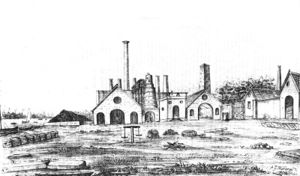Port Novo Iron Works and early Locomotive Experiments: Difference between revisions
mNo edit summary |
m 'Further Information' added |
||
| Line 21: | Line 21: | ||
These experiments were important in the developing the [[Red Hill Railroad]] at [[Chintadripet]] by Captain [[Arthur Thomas Cotton]] which was constructed in 1836 and opened 1837 for the conveying of hard laterite to be used as road-building material. It was the first railway in India.</blockquote> | These experiments were important in the developing the [[Red Hill Railroad]] at [[Chintadripet]] by Captain [[Arthur Thomas Cotton]] which was constructed in 1836 and opened 1837 for the conveying of hard laterite to be used as road-building material. It was the first railway in India.</blockquote> | ||
==Further Information== | |||
See '''[[Early Railway Experiments and Proposals]]''' for more information and background. | |||
==References== | ==References== | ||
Latest revision as of 07:22, 5 January 2017
Port Novo Iron Works and early Locomotive Experiments
Port Novo Iron Works

In c.1830 a Mr Heath, then Agent for the East India Company (EIC) proposed the manufacture of iron based on the mineral deposits of magnetic oxide near Salem [1].
Following trials the Mr Heath formed a Company with works at Porto Novo on the Coromandel Coast at the mouth of the Vellur River to produce high quality manganese iron [1].
The ores were prepared near Salem and conveyed by water to Porto Novo. The charcoal for the works was obtained from the extensive jungle at the mouth of the Coleroon River[1].
The Works thus became the first Iron Works in India [2].
After three years, in which Heath’s Iron Works produced pig iron of the highest quality, yet remained unprofitable, the company was saved from bankruptcy by an advance from the Madras Presidency, who renamed the works ‘The Indian Iron and Steel Company’. Following further financial difficulties the Madras Presidency intervened again in 1853, at which time the company was reinstated as ‘The East India Iron Company’, this fared little better and closed permanently in 1874 [3].
Locomotive Experiments
Captain Arthur Thomas Cotton of the Madras Engineers started experiments with steam engines in the middle of the 1830’s. He first took measurements from a static steam engine which was used to break rocks at the annicut (irrigation weir) being built across the Coleroon River about 35 miles down river from Trichinopoly. The machine had been built as an experiment and operated at a low pressure of 30lb/ft. It was effective and raised the hammer 30 times a minute and gave an power output of about 1:37th HP. The experiments carried out showed what happened when cylinders sizes were altered along with the orifice sizes [4]
With this information they arranged further experiments at the Port Novo Iron Works. On the 5th May 1838 they started and by 31st May they had the workings of a locomotive. This unit never ran on rails but was used to power a lathe. It was calculated that a locomotive would run up to 22.5 mph (35Km/h) [4].
These experiments were important in the developing the Red Hill Railroad at Chintadripet by Captain Arthur Thomas Cotton which was constructed in 1836 and opened 1837 for the conveying of hard laterite to be used as road-building material. It was the first railway in India.
Further Information
See Early Railway Experiments and Proposals for more information and background.
References
- ↑ 1.0 1.1 1.2 "Indian Engineering", December 3rd 1887, vol 2, pages 368-369; Retrieved 30 Sep 2016
- ↑ Wikipedia “Parangipettai” (formerly Porto Novo); Retrieved 30 Sep 2016
- ↑ Google Books “Criminal Capital: Violence, Corruption and Class in Industrial India” by Andrew Sanchez page 24; Retrieved 30 Sep 2016
- ↑ 4.0 4.1 “Reports, correspondence and original papers on various professional subjects connected with the duties of the Corps of Engineers, Madras Presidency” by Capt. John Thomas Smith. T. Smith. Vol. 1; Section Xl “Notes on some experiments made by Captain A. Cotton” Pages 95-100; Retrieved 30 Sep 2016